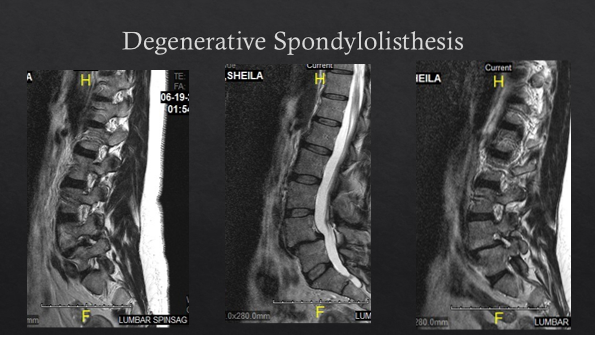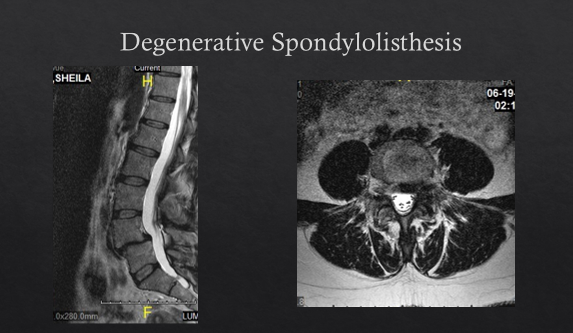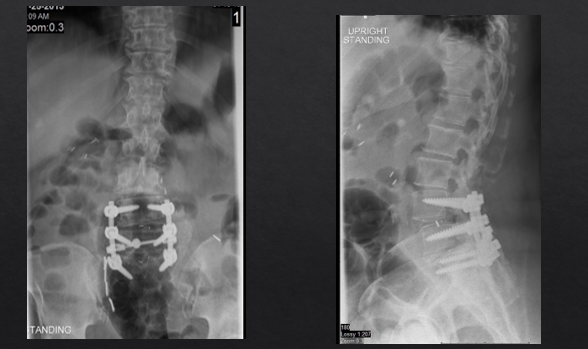There are times when patient anatomy, unique pathology, patient health concerns, possible prior surgeries, or other factors guide the surgeon to recommend a posterior-only approach to spinal fusion. Transforaminal lumbar interbody fusion (TLIF) and posterior lumbar interbody fusions are two methods for obtaining access to the disc space from posterior. They vary a bit in how they obtain access. Transforaminal removes the facet joint to widen the path where the nerve exits and through which to access the disc space. Posterolateral slightly slides the spinal canal contents medially to create a window between the dural sac containing the nerves and the facet joint to approach the disc space.
What Is A TLIF Procedure?
As is the case with spinal fusion procedures, the goal of the operation is to access the disc space to place an implant to promote stability and fusion of the two vertebrae. The most common underlying issues that lead to the need for a fusion procedure are degenerative disc disease, spondylolisthesis and scoliosis, all of which involve damage or degeneration in the spinal column that can lead to painful disc movement or vertebral shifting
The TLIF or PLIF operation takes anywhere from 2-3 hours to complete depending on the extent of pathology and number of levels to be addressed. It begins with the patient lying on their back on the operating table. General anesthesia is administered before the patient is carefully rolled by the surgical onto their stomach on the cushioned operating table. The spinal areas above the damaged discs are then cleansed and prepped.
1 Level Surgery Example




Multi-Level Surgery Example


Incision Placement
The decision for placement of the incision depends on whether work needs to be done in the spinal canal to decompress the nerves with a laminectomy or laminotomy. A TLIF can be performed through two small incisions on either side to place pedicle screws and the interbody implant. A PLIF requires a central incision to access the spinal canal and create the window to the disc space. Specialized retractors and surgical tools are inserted to help move spinal muscles and soft tissues out of the way so that the spinal column can be accessed. Part of the facet joint is then removed to help enlarge the foraminal opening through which key nerves pass, giving them more space. Any offending bone spurs are then removed before the surgeon sets their site on the damaged disc.
The surgeon then carefully removes the inner portion of the spinal disc while leaving the outer layer in place. Specialized tools are then used to prepare the nearby bone surfaces before a trial disc is inserted into the vacated disc space. This helps the surgeon understand the precise measurements of the new opening. Once the surgeon is satisfied with the fit, its location is confirmed with imaging techniques to ensure it truly is in the optimal spot to support the spine.
Restoring Disc Height & Providing Stability
To restore the height of the disc space and provide stability, an implant is chosen that fills the intervertebral space – width, depth, and height. The implant may be made of either a hard plastic or titanium. It is filled with and surrounded by bone that was removed during the exposure of the spine and decompression of the nerves as well as donor bone as needed to obtain an optimal volume for fusion.
With a posterior-only approach, additional fixation is necessary to hold the spine in an optimal and rigid position for fusion. Pedicle screw fixation with screws and small rods on either side of the spine are utilized. Once the implants are in the acceptable position, the surgeon removes their tools and carefully guides all previously maneuvered tissues back into their original location before closing the incision site. The patient is then transferred to a recovery room to rest while they come out of anesthesia. Patients will typically spend 1 to 2 nights in the hospital while they recover.
Recovering from the TLIF Procedure
As with all fusion procedures, you’ll be given instructions on how to proceed with a number of aspects of your recovery, including managing your incision site, your physical therapy and your activity limitations. We’ll follow and guide you closely during the recovery, expanding activities as the spine progressively heals.
For more information about the treatment options for low back and leg pain, reach out to Dr. Jackman and his care team today.

